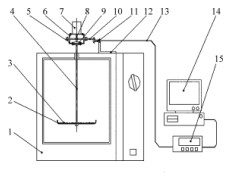
- Shandong Microwave Machinery Co.,Ltd.
- To be the Leader of microwave drying and edible oil refining equipments Manufacturer
Home> Company News> Study on variable temperature control method of Apple microwave drying
- AddressNo. 225, Huangqiao Village, Beiyuan, Tianqiao District, Jinan, Shandong, China
- Factory AddressNo. 225, Huangqiao Village, Beiyuan, Tianqiao District, Jinan, Shandong, China
- Phone(Working Time)+86 0531 85064681
- Phone(Nonworking Time)0086-15020017267
- Fax+ 86 0531 85064682
Study on variable temperature control method of Apple microwave drying
2018-10-30 10:19:11Abstract: Microwave drying equipment can effectively shorten the drying time and improve the quality of apple dehydration. Six constant temperature microwave drying schemes and three variable temperature microwave drying schemes were used to study the drying characteristics and quality of apples under different schemes.
The experimental results show that the drying rate of "constant temperature" drying scheme decreases slowly in the middle drying stage, which will result in lower quality of products. In the "drying rate control" scheme, the drying rate is controlled at a constant speed in the middle of drying, but there are some defects in the initial drying control; in the "linear temperature control" scheme, the drying rate is basically maintained at a constant speed in the middle of drying, and the drying time and energy consumption are reasonable, sensory quality and color quality are superior to the constant temperature drying; In the three-stage temperature control scheme, the complexity of the equipment used in the linear temperature control scheme is simplified. Although the product quality index is slightly decreased, the equipment is simplified, which is more conducive to industrial application. This study provides a technical basis for the application of microwave drying technology to Apple drying theory.
Key words: microwave drying, drying rate, temperature change, apple
Microwave drying technology is widely used in food industry because of its high efficiency and low energy consumption. In the process of Apple microwave drying, the electromagnetic wave emitted by magnetron directly acts on the ions and dipole molecule of the material, causing its vibration and mutual friction to produce heat, thus rapidly increasing the temperature of the object. If the magnetron stops working, the action of ions and dipole molecules in the object will stop immediately, and the temperature will drop faster than other ways of heating and drying from outside to inside. Therefore, by automatically adjusting the microwave power can quickly and effectively control the temperature of the object in the microwave drying process.
In the process of drying, if the parameters are set improperly, the material will easily destroy the internal structure, lose the flavor and scorch the surface in the process of rapid dehydration, thus affecting the quality of the product. In order to solve these problems, a large number of researchers have done corresponding work for a long time. Cherry, beet root and carrot were used as test materials to study the effect of temperature change on the quality of hot-air drying process by changing the temperature of hot-air. The results showed that the temperature change drying could improve the quality of the product better than the constant temperature drying by reasonably controlling the parameters. Temperature measurement was added in microwave vacuum drying to control microwave power, reduce the effect of temperature exceeding the limit on the product, and improve the quality of grape drying. Using two-stage heat pump to make banana slices drying at variable temperature, it can effectively reduce time consumption and improve color quality.
Intermittent drying of durian honey was carried out by intermittent heat pump dryer, and the optimal drying conditions were determined. The drying characteristics of Saint Lady's fruit were studied by means of segmental internal circulation hot air drying technology, and the ideal experimental results were obtained. The drying characteristics of Momordica charantia slices under constant temperature and variable temperature hot air drying were studied. It was concluded that variable temperature drying could retain better color than constant temperature drying.
A large number of studies on temperature change at home and abroad focus on hot air drying, and few reports on drying rate control during microwave drying. In order to improve the drying quality, Apple was dried at six constant temperatures, and the drying results were analyzed. A variable temperature drying scheme was proposed to control the drying rate at different drying stages. At the same time, the variable temperature drying scheme was improved to simplify the equipment on the basis of guaranteeing the drying quality and to provide technical basis for industrial application.
 High efficiency food beverage factory stone paper production line
High efficiency food beverage factory stone paper production line Factory price Fully automatic Machine PP/PS Plastic Sheet Production Line
Factory price Fully automatic Machine PP/PS Plastic Sheet Production Line used deformered bar rolling mill production line
used deformered bar rolling mill production line Manufacturing plant automatic factory puffed sticky rice cracker production line
Manufacturing plant automatic factory puffed sticky rice cracker production line Production Line Pp Ppr Plastic Pipe Making Machine 20-63mm Multi-layer Extrusion Production Line For Water Supply
Production Line Pp Ppr Plastic Pipe Making Machine 20-63mm Multi-layer Extrusion Production Line For Water Supply